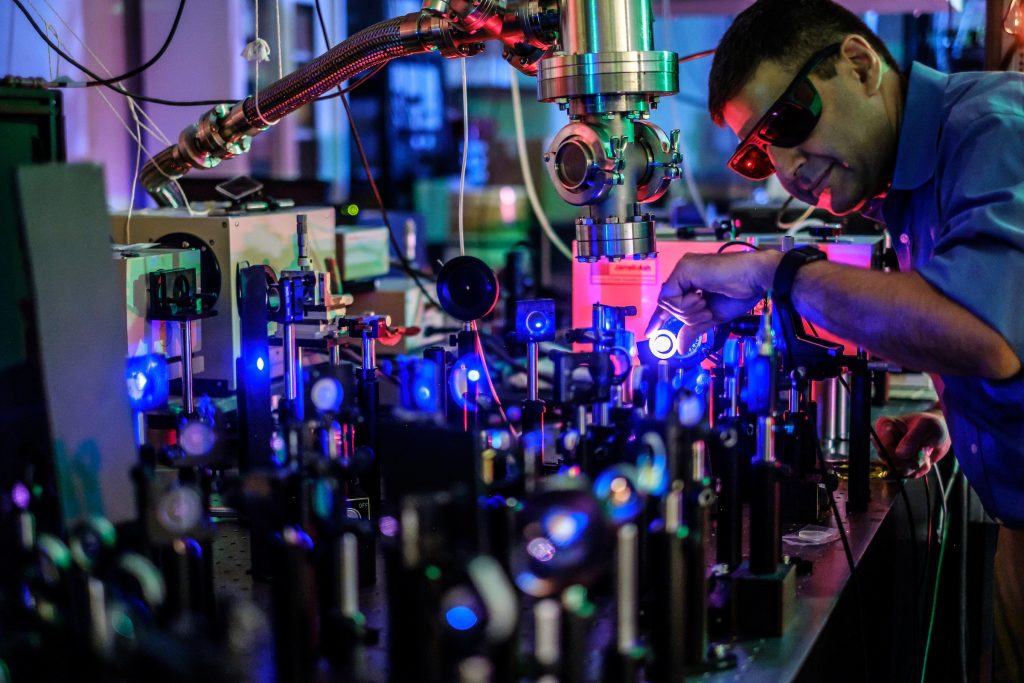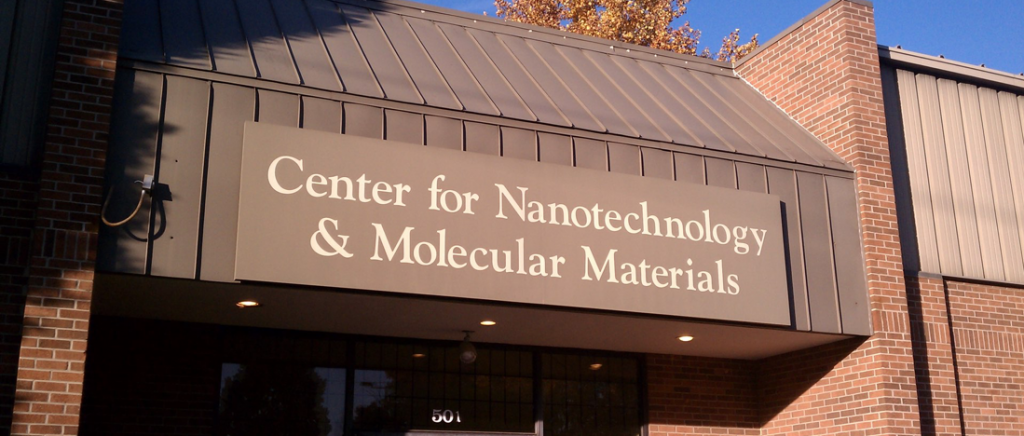Facilities
WFU Physics Facilities
Olin Physical Laboratory

The Department of Physics is located in the Olin Physical Laboratory, built in 1989 after the Department chair George P. (Jack) Williams received a grant from the F. W. Olin Foundation. Located near the center of the campus. The building has excellent space for teaching, research, and study.
Specialized Laboratory Equipment
Well-equipped facilities are available for experimental and computational research including the following:
Laboratory for laser interaction with materials
This includes a subpicosecond amplified Ti:sapphire laser, optical parametric amplifier, delay lines, optical multichannel analyzer, and streak camera for time- resolved studies.

Materials preparation equipment
Facilities include a thin-film physical vapor deposition (PVD) instrument which is capable of accurately depositing layers of materials ranging from metals, to organic solids, and oxides. For more information about this instrument which is available for use by all WFU students, faculty and staff, please follow the link.

Spectroscopy and analysis instruments for biophysics research
Various equipment is also available for spectroscopy on biological and other samples. These include a Bruker EMX electron paramagnetic resonance (EPR) spectrometer capable of measuring samples at room and low (down to 4 K) temperatures, an OLIS RSM spectrometer capable of millisecond time resolved absorption, scattering and fluorescent measurements as well as freeze-quench capabilities for EPR, and a Cary 100 spectrometer with a multiple cell exchanger and integrating sphere for spectroscopy of turbid samples.
Equipment that is used to analyze blood and other tissue samples includes a hemox analyzer to measure oxygen saturation curves of hemoglobin, and a laser-assisted ektacytometer to measure red blood cell deformability and fragility. There are also instruments to measure nitrite, nitrate and other NO congeners; an EICOM ENO 20 and a Sievers NOAi.
Sample preparation facilities for biophysical research
The biophysical research laboratories include equipment such as vibration isolation tables (Halcyonics), a UV-ozone surface cleaner (Samco), and standard molecular biology equipment such as miscellaneous PCR cyclers, centrifuges, incubators, shakers, hoods, pH meters, freezers, refrigerators, electrophoresis apparatuses, gel documentation equipment (e.g., transilluminator and cameras), chemical cabinets, balances, heater/stirrers, nano-pure water, -80˚C and -20˚C freezers and refrigerators, and electrospinning equipment (glove box, power supplies, syringe pumps, mandrels, vacuum pumps, lab jacks) is set up next to a ventilation hood.
Additionally, cell culture facilities include 2 liquid nitrogen cell repositories (MVE Cryogenics and Fisher Scientific Cryoplus); a Nikon Eclipse Ti; nano-pure water, an autoclave; a french press; an HPLC-MS; a Bio-Rad BioLogic DuoFlow QuadTech combination FPLC/HPLC and a BioLogic HR FPLC; a Beckman Coulter LS 6500 scintillation counter; an Aviv 215 Circular Dichroism spectrometer; a Bio-Rad FX-ProPlus Molecular Imager; a BioRad 583 gel dryer; a Bio-Rad ChemiDoc XRS CCD Imaging system; a Kodak EDAS 290 gel documentation system; a Bellco Tissue Culture incubator; a Labconco 4-ft laminar flow hood; an Olympus IMT-2 inverted microscope, liquid nitrogen, and any common solvent/reagents.
Optical and atomic force microscopy
A significant amount of Biophysics research and Optics uses optical and AFM microscopes. The department houses several high-grade research microscopes which are described in greater detail in the link.
Center for Nanotechnology and Quantum Materials at Wake Forest University
The Center for Nanotechnology and Quantum Materials (NANOTEQ) ![]() is located adjacent to the Reynolda Campus of Wake Forest University 501 Deacon Blvd., NANOTEQ offers over 6000 sq. ft. of dedicated lab space. Facilities include a electron microscopy and materials characterization facility (HRTEM, FE-SEM, CTEM, STM/AFM, XPS, Scanning Auger, EDAX), a cleanroom facility (Class 1000, sputter deposit, PECVD, thermal evap, and organic device fab.), a solar testing facility (AM1.5g Class A standards vertically and laterally mounted, EQE, IQCE, power efficiency.), and a growth and synthesis lab (anything from CVD to polymer synthesis can be worked out here)
is located adjacent to the Reynolda Campus of Wake Forest University 501 Deacon Blvd., NANOTEQ offers over 6000 sq. ft. of dedicated lab space. Facilities include a electron microscopy and materials characterization facility (HRTEM, FE-SEM, CTEM, STM/AFM, XPS, Scanning Auger, EDAX), a cleanroom facility (Class 1000, sputter deposit, PECVD, thermal evap, and organic device fab.), a solar testing facility (AM1.5g Class A standards vertically and laterally mounted, EQE, IQCE, power efficiency.), and a growth and synthesis lab (anything from CVD to polymer synthesis can be worked out here)

Wake Forest University DEAC Linux Cluster
The Wake Forest University (WFU) Distributed Environment for Academic Computing Cluster (DEAC Cluster) is available to WFU faculty, staff, and students. The DEAC Cluster’s primary mission is to provide a stable, robust, and accessible computational resource that allows the education and research communities to focus on their primary missions.

Medical Physics Facilities
Resources and facilities include graduate student offices, well-equipped computer laboratories, state-of-the-art diagnostic and radiation treatment devices, experimental irradiators, and clinical and experimental instrumentation in the Departments of Radiation Oncology, Radiology, Biomedical Engineering, and Physics. The Comprehensive Cancer Center of Wake Forest University is an NCI-credentialed Comprehensive Cancer Center, providing robust resources for cancer research and enabling retrospective and prospective pre-clinical and clinical research to be conducted under the auspices of institutionally-approved protocols. Wake Forest University and Virginia Polytechnic Institute have a joint School of Biomedical Engineering and Sciences (SBES). This affiliation provides the resource strengths of each campus to the other, such as the veterinary, medical and engineering sciences.
WFU Library Facilities
The adjacent Z. Smith Reynolds Library houses a substantial collection of research journals and monographs.
